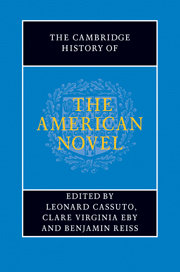Book contents
- Frontmatter
- General Introduction
- PART ONE INVENTING THE AMERICAN NOVEL
- PART TWO REALISM, PROTEST, ACCOMMODATION
- PART THREE MODERNISM AND BEYOND
- PART FOUR CONTEMPORARY FORMATIONS
- Introduction: contemporary formations
- 58 Postmodern novels
- 59 The nonfiction novel
- 60 Disability and the American novel
- 61 Model minorities and the minority model – the neoliberal novel
- 62 The American borderlands novel
- 63 The rise of the Asian American novel
- 64 Toni Morrison and the post-civil rights African American novel
- 65 Hemispheric American novels
- 66 The worlding of the American novel
- 67 The Native American Tradition
- 68 Contemporary ecofiction
- 69 Graphic novels
- 70 Twentieth- and twenty-first-century literary communities
- 71 A history of the future of narrative
- A selected bibliography
- Index
71 - A history of the future of narrative
from PART FOUR - CONTEMPORARY FORMATIONS
Published online by Cambridge University Press: 28 July 2011
- Frontmatter
- General Introduction
- PART ONE INVENTING THE AMERICAN NOVEL
- PART TWO REALISM, PROTEST, ACCOMMODATION
- PART THREE MODERNISM AND BEYOND
- PART FOUR CONTEMPORARY FORMATIONS
- Introduction: contemporary formations
- 58 Postmodern novels
- 59 The nonfiction novel
- 60 Disability and the American novel
- 61 Model minorities and the minority model – the neoliberal novel
- 62 The American borderlands novel
- 63 The rise of the Asian American novel
- 64 Toni Morrison and the post-civil rights African American novel
- 65 Hemispheric American novels
- 66 The worlding of the American novel
- 67 The Native American Tradition
- 68 Contemporary ecofiction
- 69 Graphic novels
- 70 Twentieth- and twenty-first-century literary communities
- 71 A history of the future of narrative
- A selected bibliography
- Index
Summary
The future of the American novel begins in Sumer at the beginning of the Bronze Age something over 5,000 years ago with the development of a new technology called writing. Like all freshly invented technologies, the new writing system had to undergo a certain amount of experimental beta time (a millennium or so) before procedures became standardized and something like an accepted alphabet and grammar emerged, for one of the first things that was no doubt discovered was that writing was like speaking, but it was not speaking, and new protocols had to be formulated. Though it probably began as an accountancy mechanism for an agrarian society (some of the oldest written inscriptions concern grain harvests and the production of beer and its distribution), it eventually evolved into a more flexible and broadly applicable tool, opening up several new career opportunities – scribe, teacher, scholar, recorder, archivist, historian, preparer of tablets, mathematician, to name but a few – and making literacy a form of empowerment. Parents sent their children to writing schools to secure their futures. The cuneiform signs developed by the Sumerians were soon adopted by their neighbors and the technology spread throughout Mesopotamia, and eventually into South Asia, Africa, Europe, and on into the New World, a parallel but very different development getting off the ground in Asia two or three millennia after the Sumerians first pressed stylus to clay, promoted by Chinese priestly fortunetellers. With a notable exception or two (e.g., the Mayans), all known writing systems of the world are believed to descend ultimately from either the early inventions of the Sumerians or those of the Chinese.
- Type
- Chapter
- Information
- The Cambridge History of the American Novel , pp. 1168 - 1181Publisher: Cambridge University PressPrint publication year: 2011
- 1
- Cited by



